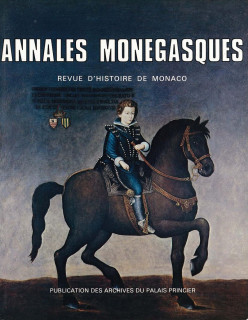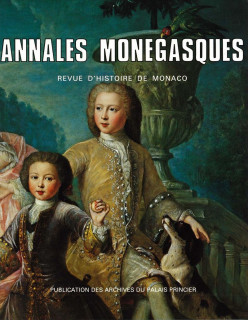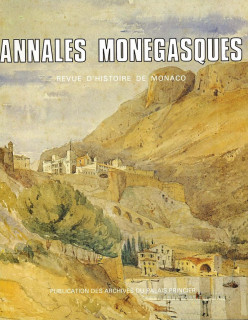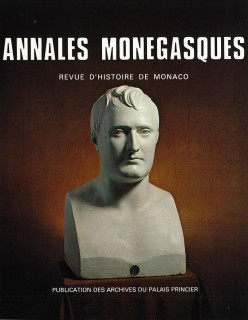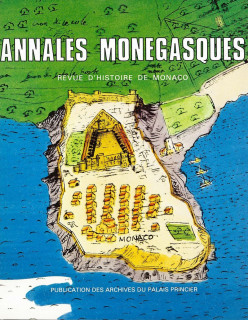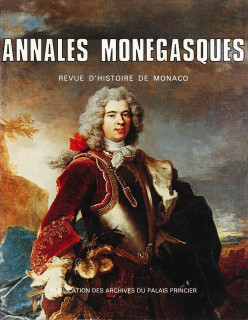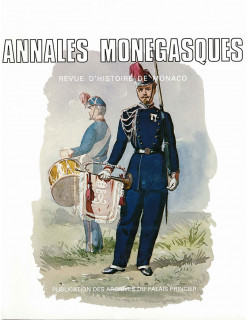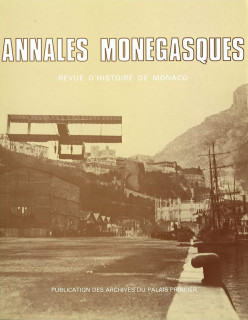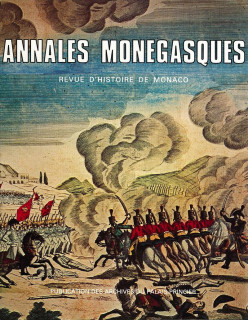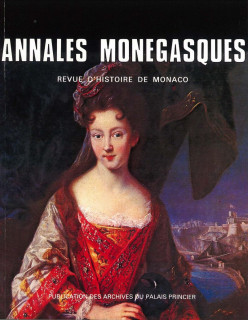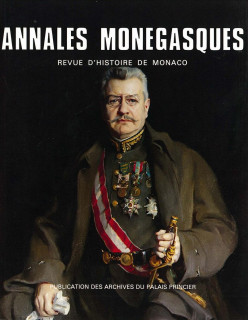
Annales monégasques

Summary
This issue is largely dedicated to the contemporary history. The Revolution and the fall of the Empire are both episodes covered in two articles. In more recent times, the review describes the visit of Maupassant in Monaco in 1887 and the publication of some fanciful pages regarding this country. Two years later, Monaco participated to the Universal Exhibition of 1889, by introducing the works of Prince Albert I. Louis II’s military career is also studied, while the “Archives document” presents a 19th century manuscript about the Devota feast day. (full texts in French)
Summary
Two articles highlight an anecdote linked to the history of the Palace: the death of Duke of York, brother of King George III of the United Kingdom, in Monaco in 1767. The first article covers the life of Duke of York, his death and funeral, while a second study is dedicated to the visit of Prince Honore III to England as a consequence of this tragic event. Then, another article deals with the works done on the Palais de Carnolès and on the old organs of Saint Nicholas Church. This issue also covers the counter-revolution which took place in the region, and the exceptional career of Raoul Gunsbourg, director of the Monte-Carlo Theater for six decades. (full texts in French)
Summary
Four articles illustrate the major stages of the Monaco modern history : First of all, the relationships between the Spanish and Monegasques, at the time of Charles Quint ; then, the life of Charlotte-Catherine de Gramont within the French court ; and finally, the sumptuous accession of Prince Honoré III which reflected the French model. A presentation of the correspondence between Montaigne and the Marshal Jacques II de Goyon de Matignon, allows us to discuss the Guyenne history in the 16th century. This issue also covers the law of the sea, the religious history and the human paleontology. (full texts in French)
Summary
In this issue, art is in the spotlight. After a study about François-Joseph Bosio published in the previous issue of Annales monégasques, an article is now dedicated to his brother, the painter Jean-Baptiste Bosio. Moreover, another article deals with an anonymous album of drawings from the 19th century. The review also presents old maps and views of Monaco, as well as a study about names in the Monaco modern age society. (full texts in French)
Summary
In this issue, the Annales monégasques deal with very different topics. That is to say, arts and letters, through the sculptor’s life named François-Joseph Bosio, “The Child and the Spells” by Ravel, and the philosophical reflections of Jacques de Goyon-Matignon, Duke of Valentinois. The important stages of the construction of Monaco are also discussed : Charles d’Anjou’s action in the 13th century, and the installation of the railtrack in Monaco in the 19th century. Finally, a study regarding the population of Menton and Roquebrune in the Middle Age, completes an article in the previous issue. (full texts in French)
Summary
The section " Document of the year " deals with a founding event : the Spanish garrison’s eviction from Monaco in 1641. This issue also refers to social topics, through an analysis of the Monegasque population in the Middle Age, and the participation of the S.B.M. to popular and carnival festivities in Nice, in the late 19th century. The contemporary history is also presented as René Diana covers the third part of his study about the military career of Honoré V, under the Empire. Hélène Day recounts Albert I’s trips to the United States. To finish with, an article deals with the battle of Menton against the Italians in 1940, relying on the available information about the Second World War. (full texts in French)
Summary
This issue describes, through the old chapels of Monaco, a part of the principality’s religious and heritage past. Then, the artistic and nonmaterial heritage is discussed thanks to Louis Abbiate and Gustave Graefe, both well-known Monegasque musicians, but also Jacques de Goyon-Matignon, Duke of Valentinois, who was a nobleman of letters. On the other hand, two tragic incidents are recounted : the conspiracy of Stefano Boccone, and the Second World War, which is the topic of an overall study. (full texts in French)
Summary
The "Archives documents" section summarizes a text from an interesting ethnographic archive entitled "Researches about Monaco" from the late 18th century and the beginning of the 19th century. It’s a manuscript which highlights the concerns and the wonders of a local scholar. This analysis is complemented by the traditional princes’ biographies, thanks to the following topics : the numismatic collection, the wedding, the guard and the army career. The creation of "The Damnation of Faust", in the Raoul Gunsbourg version, the legendary Director of the Monte-Carlo Opera from 1892 to 1951, is the theme of the musical history section. (full texts in French)
Summary
The Mediterranean sea is at the core of this issue. Indeed, it covers an academic study dedicated to the olive tree from the Middle Age to modern times, written by Jean-Baptiste Robert. The military history is explained in two articles : one of them completes the review about the fortress, previously published; the other one deals with the 18th century war which impacted the Principality. Antoine I’s biography entitled "A French prince", illustrates the acculturation process achievement that affected the dynasty in the late 17th century and the beginning of the 18th century. The Belle Epoque in Monaco is related through its urban expansion and its tendency towards new technologies. (full texts in French)
Summary
This forth issue covers the former fiefs of the dynasty in France, the soldier career of a prince who became a French citizen because of the Revolution; and the trade and health relationships between Monaco and Marseille in the 18th century. This issue also deals with music, literature and numismatics. (full texts in French)
Summary
This issue presents a biography of the only Sovereign Princess of Monaco, but also an interesting archeological study about the ramparts of the fortress of Monaco. The Principality’s musical history is covered, as well as the sovereignty foundations and the dynasty inheritance. This issue also talks about a famous visitor from the 17th century, and his view of Monaco. (full texts in French)
Summary
This issue highlights two dynastic and ecclesiastical figures : Antoine I‘s brother, bishop of Besançon at the beginning of the 18th century, and Augustin Grimaldi, both bishop of Grasse and Lord of Monaco at the beginning of the 16th century. Coins and stamps, language and heraldry, are here presented as a showcase of the sovereignty. The summary of a university degree about the Enlightenment and the overview of Prince Antoine I’s musical correspondence, highlight the integration of Monaco and its princes in the free flow of ideas and cultural practices. (full texts in French)

